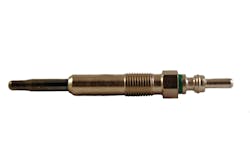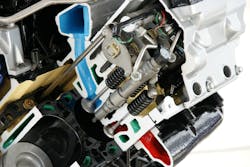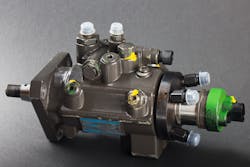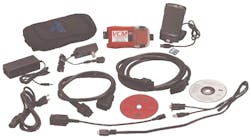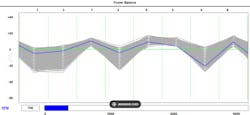What you will learn:
•What is required for diesel engine combustion to occur
•How to streamline your diesel driveability diagnostics
•Simple scan tools tests to be performed from the driver's seat
Any time I work on a diesel engine, I always think of the simplicity of the engine. Maybe this is because of my background in diesel, which started back in the 1960s. Back then, the diesel engines were pretty basic, and I actually found them easier to diagnose problems on than their gasoline counterparts. For the moment let’s take a step back to the basics of how the diesel engine works, which would get us all started out on the same page. The diesel engine has no ignition system and relies on high compression and heat in the combustion chamber to ignite the diesel fuel that is sprayed (injected) into the hot combustion chamber at the correct time and in the correct amount. This boils misfire diagnosis down to only three things: fuel quality, compression and fuel injection.
A closer look
Diesel fuel has more things to do in the engine than simply burn in the combustion chamber. It has to also lubricate the injection system, seal the injection pump and injectors and cool the injection system. Combustion chamber heat comes from two things: compression pressure and glow plug heat. Without the proper compression, the combustion chamber gas temperature will not be hot enough for ignition to take place. For most diesel engines, the combustion temperature has to be at least 450° F before the engine will start. To get this to happen, most late model engines will use some sort of engine starting aid. This might be a glow plug tip protruding into the combustion chamber, or an electric heater inside of the intake manifold. Sometimes these electric heaters are used for starting and sometimes they are used for emission control to keep the exhaust from blowing a cloud of smoke when the engine has started, but no matter what is used, the starting aids are used only for starting and once the engine is running the starting aids will not be the cause of a misfire. It’s this misunderstanding of how a glow plug works that often leads gas guys astray. They are not spark plugs!
The fuel injection system is probably the most problematic part of the combustion process. Basically, there are two distinct types of fuel injection systems. One type is a unit injection system where there is no traditional fuel injection pump (common rail and Hydraulic Unit Electric Injector (HUEI) for example). The other type is known as the Pump Line Nozzle (PLN) system where an injection pump is mounted to the engine and high-pressure lines carry the fuel from the injection pump to the fuel injectors, fitted into the combustion chamber. Each of these fuel systems will require a different diagnostic approach.
The basics of misfire diagnosis will always be the same. The key is to find the combustion process element that is lacking. In the case of a diesel, find out whether the problem is caused by lack of combustion chamber heat or lack of fuel injection. Notice I did not say anything about low compression or glow plug operation, because either of these can cause insufficient combustion chamber heat and must be considered in the phase of the diagnostic process.
Down and dirty misfire detection
Misfire detection has changed a lot in the last few years. Back in the day, it was quite easy to loosen a fuel injector line while the engine idled and listen for the idle speed to change, or to hear the engine start loping as we moved the fuel injection charge outside of the combustion chamber. Those methods have no place in modern diagnostic and can even be unsafe when tried on some systems.
Instead, we are going to use a lab scope and a scan tool to find these misfires. Many times, all of the work can be done from the front seat of the vehicle using just a scan tool. With the advent of OBDII, scan tool capabilities only seem to get better every year. In today’s world of diesel diagnostics, most every engine manufacturer gives some sort of cylinder contribution data on the scan tool. Some manufacturers only provide “at idle” date, while others also make it available at higher engine rpm. This data is an indication of the fuel injector control that is needed to keep the engine running smoothly. For you gas guys, you might think of this as fuel injector fuel trims. This data is valuable not only when looking for a misfire, but when looking for rough running engines or poor power complaints. With a little practice it is possible to use your scan tool to test the fuel injectors while they are still in the engine. Stop and think how valuable this can be since it will save you a lot of time in testing without the need to remove all the injectors and send them off for testing. One other benefit of this type of testing is the injectors are tested dynamically in their real-world working conditions. This is something that no injector test bench can do. The power of the scan tool bidirectional controls is awesome. All engine manufacturers allow several bidirectional and scan test options. When working on common rail engines, things like control of rail fuel pressure, turning off individual fuel injectors, relative compression testing and much more are available. The HUEI systems allow for injector electrical tests (injector buzz test), high-pressure control and cylinder contribution tests. Learning how to use your scan tool and how to quickly move from test to test will make your testing procedures quicker and more accurate. There are also the diagnostic trouble codes available to get a direction for diagnosis, but I caution you about using codes alone as a basis to replace parts, since this can lead you down some long dark damp alleys of trial and error.
Lab scopes and diesels
If a relative compression test is not available on your scan tool, then you can use a lab scope and a high amp current probe to do the testing. Having to pull valve covers, heat shields and glow plugs can be very time consuming to do a mechanical compression test. One thing to understand about relative compression testing is that while the actual compression pressure cannot be determined, the test can provide a quick comparison between cylinders.
Many times, a lab scope is needed to enhance the diagnostic capabilities of the scan tool. One instance is a relative compression test. As engines get more complicated, it is a must to have quicker and easier diagnostic procedures. Because compression is one of the essential ingredients for combustion, relative compression is a great way to find that low compression cylinder without having to remove engine parts or covers.
If you are looking for the cause of a misfire on one cylinder and you have five other cylinders that are working, you have a way to compare the misfiring cylinder. In a case like this, your relative compression test will save you a lot of time and will give you great results. Hook your high amp current probe around a battery cable that powers the starter, trigger from a cam position sensor (CMP) so you have a reference to your waveform and give the engine a short crank.
While we are talking about using a lab scope on diesels, I think it would be good to consider how the injection system/computer controls work. If you’re comfortable with gasoline engines and how the ignition and fuel injection systems are controlled, you’re well on your way to being able to diagnose modern diesels. The electronic diesel injection control is about the same since they also use a crankshaft position sensor (CKP) and CMP sensor to report the crankshaft and camshaft positions to the engine control module (ECM). If these signals are not correct or corrupted, misfires can occur. In some cases, a lab scope will be required in the diagnostic process to scope these signals. With the electronic injector control, it is possible to have one cylinder fire out of time or not fire at all if the CKP does not report properly.
A poor running 2006 F250
Let’s look a real-world example I had of a misfiring diesel to illustrate the process. The vehicle is a 2006 F250 6.0L engine, manual transmission with 245,000 miles on the odometer. Please keep in mind that this vehicle is used as an example and whether you are working on a Dodge, Chevrolet or a Ford, the diagnostic processes will be about the same.
In any diesel engine, all we need is the proper cylinder heat, a fuel that is capable of combustion and injected into the combustion chamber at the proper time and in the proper amount. The complaint of this vehicle is lack of power and a rough idle. Any time I get a problem vehicle like this, I always wonder what people really expect out of their vehicles. When I opened the driver’s door, I immediately knew how this truck was being used. A company that does pack trips with horses and mules owns the truck, which was evident by the smell that came rolling out of the cab and the brown stuff that was on the floor of the driver’s compartment.
Being raised a farm boy, this didn’t bother me at all. I just took it in stride. I came armed with my IDS scan tool and all the while; the same thoughts kept running through my mind. Do some faulty injectors or low compression cause this misfire, or is the problem electrical in nature? Any and all of these problems could be the cause of the misfire on this engine, so let’s use the power of the scan tool to see if we can quickly get to the bottom of this problem. The vehicle has been sitting overnight, so before the engine is started, I want to check for any diagnostic trouble codes that might be stored in memory. In the case of this vehicle, there are several codes set.
- P0272 = Cylinder No. 4 contribution
- P0275 = Cylinder No. 5 contribution
- P0281 = Cylinder No. 7 contribution
- P0299 = Turbocharger under boost
- P0478 = Exhaust pressure control valve high input
Any time I get this many codes on a diagnostic problem, I try to break them down into two or three different categories. That way I can divide and conquer without getting confused. The three cylinder-contribution codes are performance codes, which are set because there was no power or low power produced in these cylinders. The P0299 and P0478 codes are set because of lack of boost and because the EBP actual pressure does not agree with the calibrated limits. Both of these codes can easily be the product of the three misfiring cylinders, so I will put them on the back burner for a while and concentrate on the three cylinder-contribution codes.
From what we discussed earlier about the requirements for combustion in a diesel, we need to check for only three things: compression, fuel injector operation and a combustible fuel. Since the engine is cold and has not been started, the first thing to do is use the scan tool to do the KOEO (Key On, Engine Off) electrical injector test. This test is going to operate the electric solenoids in the injectors and test the electrical circuits of the injectors. It will test the electrical circuits from the FICM (Fuel Injection Control Module) all the way through the fuel injector coils.
When doing the test, get your head up under the hood somewhere near the center of the engine so you can hear the test being performed. The scan tool will first activate all of the fuel injector electrical solenoids then each solenoid is activated using the cylinder numbering sequence. The scan tool will run this test three times. If any of the injector solenoid valves are stuck, they will not click and you will be able to detect this with your ears. If the electrical circuits are shorted or open, diagnostic trouble codes will be set.
As the injectors are being clicked on and off, you can hear the missing clicks of the stuck solenoids as they are cycled. In this truck’s case, the injectors on cylinders 4, 5 and 7 did not click. The next test I want to do is to verify if the problem is caused by low compression on the misfiring cylinders. The quickest way to get this data on this particular vehicle is with the scan tool. This is easily accomplished by selecting the relative compression test and following the on- screen directions.
When the test is completed, the scan tool will display the relative compression data. This data is taken from the CKP sensor speed during cranking. If you do not have this function on your scan tool, you can use a lab scope and high amp current probe to get your data. Be sure and trigger from the CMP sensor when doing this test so the low compression cylinder can be identified using the engine’s firing order.
Now it's time to start the engine and select the cylinder contribution test. Here you can see which cylinders are not contributing and are able to kill each injector while watching the graph of engine rpm. My testing found there was no problem with compression. The lack of clicks in the earlier injector test led to the cause of the misfires. The hydraulic solenoids were stuck in the three silent injectors. Three new injectors fixed the power and rough running complaints and returned the engine to its original condition.
By using these three simple tests, the cause of the misfire was easily found, and all by through the use of scan tool bidirectional controls and data graphs. Once the misfiring cylinder(s) is identified, you may have to use pinpoint tests to narrow down the fault’s cause. A few examples of pinpoint tests are an injector leakage test, a balloon test (to see if compression is being blown back through an injector and collecting in the fuel rail), or a voltage drop test of the electrical circuits to verify the integrity of the circuit. You will find that starting your testing procedure with the basics, though, will get you to the finish line the quickest.

